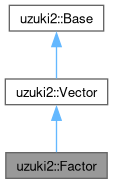uzuki2::Factor Class Referenceabstract
Interface for a factor. More...
#include <interfaces.hpp>
Inheritance diagram for uzuki2::Factor:

Collaboration diagram for uzuki2::Factor:

Public Member Functions | |
| Type | type () const |
| virtual void | set (size_t i, size_t v)=0 |
| virtual void | set_level (size_t il, std::string vl)=0 |
 Public Member Functions inherited from uzuki2::Vector Public Member Functions inherited from uzuki2::Vector | |
| virtual size_t | size () const =0 |
| virtual void | set_name (size_t i, std::string n)=0 |
| virtual void | set_missing (size_t i)=0 |
 Public Member Functions inherited from uzuki2::Base Public Member Functions inherited from uzuki2::Base | |
Detailed Description
Interface for a factor.
This is considered a "vector" in terms of its indices, not its levels. So, settings like Vector::use_names() and Vector::is_scalar() refer to the underlying integer indices.
Member Function Documentation
◆ set()
|
pure virtual |
Set the value of a factor element.
- Parameters
-
i Index of a factor element. v Value of the factor element, as an integer index that references the levels.
◆ set_level()
|
pure virtual |
Set the levels of the factor.
- Parameters
-
il Index of the level element. vl Value of the level element.
◆ type()
|
inlinevirtual |
- Returns
- The data type.
Implements uzuki2::Base.
The documentation for this class was generated from the following file:
- uzuki2/interfaces.hpp
Generated by